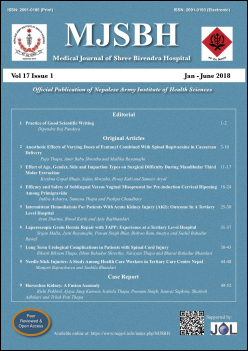Anesthetic effects of varying doses of Fentanyl combined with spinal Bupivacaine in caesarean delivery
Keywords:
Bupivacaine, caesarean delivery, Fentanyl, intrathecalAbstract
Introduction: Spinal opioids have gained popularity in recent years as they augment the analgesia produced by local anesthetics. Fentanyl is one of the opioids used for such purpose however the optimal dose has not been described adequately in the literature available so far in our setup. The aim of this study is to find out the effect of adding various doses of Fentanyl to low dose hyperbaric Bupivacaine intrathecally.
Materials and methods:Seventy-five parturients scheduled for caesarean delivery were randomly allocated into three groups (Bupivacaine-Fentanyl) BF10, BF20 and BF30 who received intrathecal 0.5% hyperbaric Bupivacaine 1.6 ml with Fentanyl 10µg, 20 µg and 30 µg respectively. Total volume was made to 2.2ml by adding normal saline. The outcomes measured were peak sensory level, degree of motor block, quality of intraoperative anesthesia, duration of effective analgesia, neonatal APGAR score and side effects were noted if any.
Results: Peak sensory level and degree of motor block was similar in all the groups. Peak sensory level (Thoracic Dermatome) was 4.52± 0.82, 4.32± 0.62 and 4.32± 0.74 (p=0.540) in BF10, BF20 and BF30 respectively. Degree of motor block was not significantly different (p=1.000). Quality of intraoperative anesthesia improved from BF10 to BF20 (P=0.040) but did not improve significantly from BF20 and BF30 (P=0.189). Duration of effective analgesia prolonged as the dose of Fentanyl increased which was in minutes 173.64±41, 216.80±32 and 273.16±35 (p=0.000) in BF10,BF20 and BF30 respectively. Neonatal APGAR scores were similar in all groups and very little adverse effects in higher doses.
Conclusion: The combination of 1.6 ml of 0.5% hyperbaric Bupivacaine and 20 µg of Fentanyl intrathecally provides excellent surgical anesthesia, prolonged postoperative effective analgesia with very few side effects. Increasing the dose of Fentanyl beyond it could prolong the postoperative pain relief but at the cost of increased adverse effects.
Downloads
Downloads
Published
How to Cite
Issue
Section
License
This license enables reusers to distribute, remix, adapt, and build upon the material in any medium or format for noncommercial purposes only, and only so long as attribution is given to the creator.




